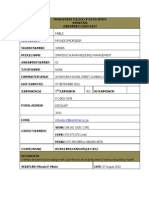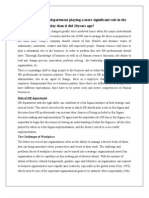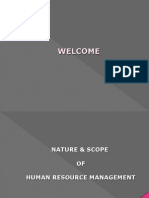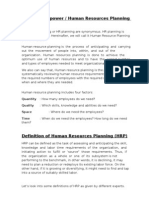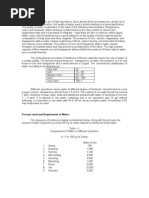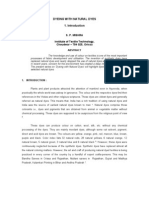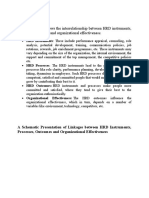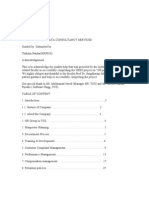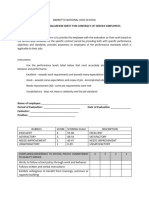Introduction To Human Resource Management
Uploaded by
Dr. S. P. MishraIntroduction To Human Resource Management
Uploaded by
Dr. S. P. MishraINTRODUCTION TO HUMAN RESOURCE MANAGEMENT
The Concept of Human Resource Management
Human resources is a term used to refer to how people are managed by organizations.
It was basically a traditionally administrative function but with time it focuses and recognizes
talented and engaged people and organizational success. Human resources has at least two
related interpretations depending on context. The original usage was traditionally called
labour. It is a measure of the work done by human beings. This perspective is changing as a
function of new and ongoing research into more strategic approaches. This first usage is used
more in terms of 'human resources development', and can go beyond just organizations to the
level of national importance. The more traditional usage within corporations and businesses
refers to the individuals within a firm or agency, and to the portion of the organization that
deals with hiring, firing, training, and other personnel issues, typically referred to as 'human
resources management'.
The terms "human resource management" and "human resources" (HR) have largely
replaced the term "personnel management" as a description of the processes involved in
managing people in organizations. In simple sense, HRM means employing people, developing
their resources, "personnel management" as a description of the processes involved in
managing people in organizations.
Human resource management is to maximize the return on investment from the
organization's human capital and minimize financial risk. Presently Human Resource
Management is an integral but distinctive part of management. Its objective is the
maintenance of better human relations in the organization by the development, application
and evaluation of policies, procedures and programs relating to human resources to optimize
their contribution towards the realization of organizational objectives. HRM helps in attaining
maximum individual development, desirable working relationship between employees and
employers, employees and employees, and effective modeling of human resources as
contrasted with physical resources. It is the recruitment, selection, development, utilization,
compensation and motivation of human resources by the organization.
Generally, human resource management refers to the management of the entire
workforce of an organization in a reliable, honest and professional manner. It is the
responsibility of human resource managers in a corporate context to conduct these activities
in an effective, legal, fair, and consistent manner. That’s why the demand of Human
Resource (HR) management has been dramatically increased these days. From corporate
sector to banking industry, from non profit organizations to human protection groups, from IT
solution companies to printing industry; human resource management is playing a critical role
in all the other sectors of the economy.
Dr. S. P. Mishra Page 1
Evolution of Human resource management
Kautilya provides a systematic treatment of management of human resources as early
as 4th century B.C. in his treatise titled "Artha-Shastra". There prevailed logical procedures
and principles in respect of labour organizations such as Shreni or guild system and co-
operative sector. The wages were paid strictly in terms of quantity and quality of work turned
out and punishment were imposed for unnecessarily delaying the work or spoiling it. The
Government used to take active interest in the operation of both public and private sector
enterprises and provided well-enunciated procedures to regulate employer-employee
relationship. Kautilya provides an excellent discussion on staffing and personnel management
embracing job descriptions, qualifications for jobs, selection procedure, executive
development, incentive systems and performance evaluation. In course of time, the guild
system was followed by cooperative sector consisting of craftsmen and traders, and
purporting to promote their professional interests. Numerous professional societies were
formed. Again, there are principles of the division of labour. The concept of "Varnashram" or
caste system was originally based on these principles. Later on, these professions emerged to
be hereditary. From the 14th century B.C. to the later half of the 10th century A.D., the
relationships between the employer and employees were marked by justice and equity.
During the Mughal rules, the India trade and commerce were revived. Several "Karkhanas"
were established at Agra, Delhi, Lahore, Ahmedabad and various other places. During early
British rules, there prevailed a laissez-faire policy towards the business. The working
conditions were appalling, living conditions were sub-human and several abuses prevailed in
indigo plantations, in tea plantation.
The above conditions prevailed till the enactment of the Factory Act of 1881.
According to the Act, the workers employed in the factories were allowed a week off-day and
provisions were also made for inspection as well as limiting he hours of work for women
workers to eleven per day. The act further provided that the minimum age of children for
employment should be seven hours and that the maximum working hours for them should not
exceed seven hours a day and that too in the day-shift. In 1890, the first labour organization
designated as Bombay Mill Hands Association was established. Subsequently, in 1905, the
printers' Union at Calcutta and in 1907, the Postal union at Bombay was established.
The Madras Labour Union was organized thereafter in 1918. In 1922, the indentured
labour system involving migration of Indian labour to other countries on contract basis was
abolished. In the same year, the Central Labour Board was established to federate the
different unions in the Bombay city and the All India Trade Union Congress was organized. The
early thirties witnessed a highly-weakened trade union movement. However, the conditions
prevailing five years before as well as during the Second World War, were conducive to the
rapid growth of the trade unionism. Between 1939-40 and 1944-45 the number of registered
trade unions increased from 666 to 865 (i.e., by 29.7 percent) and the total membership of
union submitting returns increased from 511, 134 to 889, 388 (i.e., by 70.4 percent). During
the period 1947-1960 while, industrial employment rose by 2.8 times, the total claimed union
membership also went up by 2.3 times. In 1960, 45 percent of the total industrial workforce
Dr. S. P. Mishra Page 2
was claimed to be unionized. Today, the total membership is estimated to be around 4.3
million i.e., 28 percent of total workforce.
Explicitly, during post-independence period, the activities of Personnel Department in
different public and private sectors have multiplied. According to the provisions of section 49
of the Factories Act, 1948, it became obligatory for the-employers to employ a Welfare
Officer in a factory employing 500 or more workers. Likewise, section 58 of the Mines Act,
1952, empowers the Government to specify employment of welfare officer/officers. However,
it does not mean that the functions of Personnel Department are entirely limited to welfare
activities. Management of human resources is being regarded as a specialized profession such
as that of medicine and law. In addition to the industrial relations functions (although
sometimes the industrial relations forms a separate department), the Personnel Department
is responsible for other varied functions including employment, safety, training, wage and
salary administration and research and development. The Head of the Personnel Department
is associated with top management and helps it in the formulation of personnel policies for
the company. Indeed, the activities involved in Personnel Department are akin to those
performed in this department in any other western countries.
Human Resource Management: Beliefs
The Human Resource Management philosophy is based on the following beliefs:
1. Human resource is the most important asset in the organization and can be developed
and increased to an unlimited extent.
2. A healthy climate with values of openness, enthusiasm, trust, mutuality and
collaboration is essential for developing human resource.
3. HRM can be planned and monitored in ways that are beneficial both to the individuals
and the organization.
4. Employees feel committed to their work and the organization, if the organization
perpetuates a feeling of belongingness.
5. Employees feel highly motivated if the organization provides for satisfaction of their
basic and higher level needs.
6. Employee commitment is increased with the opportunity to discover and use one's
capabilities and potential in one's work.
7. It is every manager's responsibility to ensure the development and utilization of the
capabilities of subordinates.
DEFINITION
Some of the definitions are as follows.
1. Human resource management (HRM) is the function performed in organizations that
facilitates the most effective use of people (employees) to achieve organizational and
individual goals.
Dr. S. P. Mishra Page 3
2. Human resource management (HRM) is the management of the workforce of a
business to ensure sufficient staff levels with the right skills, properly rewarded and
motivated.
3. Human resource management (HRM) is defined as staffing function of the
organization. It includes the activities of human resources planning, recruitment,
selection, orientation, training, performance appraisal, compensation, and safety.
HRM aims at developing people through work.
4. Human resource management (HRM) is defined as all methods and functions
concerning the mobilization and development of personnel as human resources, with
the objective of efficiency and greater productivity in a company, government
administration, or other organization.
5. Human resource management (HRM) encompasses those activities designed to
provide for and co-ordinate the human resources of an organization.
Personal management
Personal management is related to administrative discipline of hiring and developing
employees so that they become more valuable to the organization. It includes (1)
conducting job analyses, (2) planning personnel needs, and recruitment, (3) selecting the
right people for the job, (4) orienting and training, (5) determining and managing
wages and salaries, (6) providing benefits and incentives, (7) appraising performance, (8)
resolving disputes, (9) communicating with all employees at all levels. It is the part of
management that is concerned with people and their relationships at work. Personnel
management is the responsibility of all those who manage people, as well as a
description of the work of specialists. Personnel managers advise on, formulate, and
implement personnel policies such as recruitment, conditions of employment,
performance appraisal, training, industrial relations, and health and safety. There are
various models of personnel management, of which human resource management is
the most recent.
Differences between Personal Management (PM) & Human Resources Management (HRM)
A primary goal of human resources is to enable employees to work to a maximum level
of efficiency. So, when a difference between personnel management & human resources is
recognized, human resources is described as much broader in scope than personnel
management.
Human resources is said to incorporate and develop personnel management tasks,
while seeking to create and develop teams of workers for the benefit of the organization.
Personnel management includes administrative tasks that are both traditional and
routine. It can be described as reactive, providing a response to demands and concerns as
they are presented. By contrast, human resources involve ongoing strategies to manage and
develop an organization's workforce. It is proactive, as it involves the continuous development
of functions and policies for the purposes of improving a company’s workforce.
Dr. S. P. Mishra Page 4
Personnel management is considered an independent function of an organization. It is
typically the sole responsibility of an organization’s personnel department. Human resource
management, on the other hand, tends to be an integral part of overall company function.
With human resources, all of an organization’s managers are often involved in some manner,
and a chief goal may be to have managers of various departments develop the skills necessary
to handle personnel-related tasks.
Personnel management typically seeks to motivate employees with such things as
compensation, bonuses, rewards, and the simplification of work responsibilities. From
the personnel management point of view, employee satisfaction provides the motivation
necessary to improve job performance. The opposite is true of human resources. Human
resource management holds that improved performance leads to employee satisfaction.
With human resources, work groups, effective strategies for meeting challenges, and job
creativity are seen as the primary motivators.
There are fifteen (15) differences between Personal Management (PM) and Human
Resource Management (HRM). Those are as follows
1. Personnel mean employed persons of an organization. Management of these people is
PM. HRM is the management of employee’s knowledge, aptitude, abilities, talents,
creative abilities and skills / competencies
2. PM is traditional, routine, maintenance oriented, administrative function whereas HRM
is continuous, on going development function aimed at improving human processes.
3. PM is an independent function with independent sub functions. HRM follows the
system thinking approach. It is not considered in isolation from the larger organization
and must take into account the linkages and interfaces.
4. PM is treated like a less important auxiliary function whereas HRM is considered a
strategic management function
5. PM is reactive, responding to demands as and when they arise. HRM is proactive,
anticipating, planning and advancing continuously.
6. PM is the exclusive responsibility of the personnel department. HRM is a concern for
all managers in the organization and aims at developing the capabilities of all line
managers to carry out the human resource related functions.
7. The scope of PM is relatively narrow with a focus on administrative people. The scope
of HRM views the organization as a whole and lays emphasis on building a dynamic
culture.
8. PM is primarily concerned with recruitment, selection and administrative of
manpower. HRM takes effort to satisfy the human needs of the people at work that
helps to motivate people to make their best contribution.
Dr. S. P. Mishra Page 5
9. Important motivators in PM are compensation, rewards, job simplification and so on.
HRM considers work groups, challenges and creativity on the job as motivators.
10. In PM improved satisfaction is considered to be the cause for improved performance
but in HRM it is the other way round (performance is the cause and satisfaction is the
result).
11. In PM, employee is treated as an economic unit as his services are exchanged for
wages/salary. Employee in HRM is treated not only as economic unit but also a social
and psychological entity.
12. PM treats employee as a commodity or a tool or like equipment that can be bought
and used. Employee is treated as a resource and as a human being.
13. In PM employee are considered as cost centers and therefore, management controls
the cost of labour, HRM treats employees as profit centres and therefore, the
management invests in this capital through their development and better future
utility.
14. PM’s angle is that employees should be used mostly for organizational benefits and
profits. HRM angle emphasizes on the mutual benefits, both of employees and their
families and also the company.
15. PM preserves information and maintains its secrecy. In HRM communication Is one of
its main tasks which take into account vertical, lateral and feedback type
communication.
Differences between Human Resource Management (HRM) and Human Resource Development
(HRD)
1. HRM is a subset of the entire management processes of an organization. HRD is a
subset of HRM.
2. Scope of HRM is wider. Scope of HRD as compared to HRM is narrower.
3. HRM manages and develops the human elements of an organization in its entirely on
longer term basis. HRD focuses on those learning experiences which are organized for
a specific period to bring about the desired behavioral changes.
4. HRM emphasizes that employees, their abilities and their attitudes constitute an
important organizational as well as employee’s goals. HRD emphasizes mainly on
training and development of employees.
5. HRM takes decisions on HRD plans. HRD thus depends on the decisions of HRM.
Dr. S. P. Mishra Page 6
6. HRM is at its centre has HRD. HRD’s cooperation is important for overall success of
HRM. HRD has to work within the realm of HRM and therefore, its objectives should
be in tandem with broader objectives of HRM. Thus HRM and HRD are interdependent.
7. HRM takes care of all human needs and tries to satisfy these needs so that the
employees are motivated from all angles to contribute their best to achieve
organizational goals. HRD focuses on upgrading the skills and competencies or the
employees in order to improve the performance of the employees on the job.
Objectives of Human Resource Management
Objectives are pre-determined goals to which individuals or group activity in an
organization is directed. So objectives of HRM are influenced by organizational objectives
and individual as well as social goals.
1. To help the organization reach its goals.
2. To ensure effective utilization and maximum development of human resources.
3. To ensure respect for human beings.
4. To identify and satisfy the needs of individuals.
5. To ensure reconciliation of individual goals with those of the organization.
6. To achieve and maintain high morale among employees.
7. To provide the organization with well-trained and well-motivated employees.
8. To increase to the fullest the employee's job satisfaction and self-actualization.
9. To develop and maintain a quality of work life.
10. To be ethically and socially responsive to the needs of society.
11. To develop overall personality of each employee in its multidimensional aspect.
12. To enhance employee's capabilities to perform the present job.
13. To equip the employees with precision and clarity in transaction of business.
14. To inculcate the sense of team spirit, team work and inter-team collaboration.
Human Resource Management: Scope
The scope of HRM is very wide and vast, as seen in the diagram. All major activities in the
working life of an employee come under preview of HRM. The activities can be broadly
divided into three groups.
1. Personnel aspect This is concerned with manpower planning, recruitment, selection,
placement, transfer, promotion, training and development, layoff and retrenchment,
remuneration, incentives, productivity etc.
Dr. S. P. Mishra Page 7
2. Welfare aspect It deals with working conditions and amenities such as canteens,
creches, rest and lunch rooms, housing, transport, medical assistance, education,
health and safety, recreation facilities, etc.
3. Industrial relations aspect This covers union-management relations, joint
consultation, collective bargaining, grievance and disciplinary procedures, settlement
of disputes, etc.
Nature Employee
Of HRM Selection
HUMAN
Employee RESOURCE Employee
Education Remuneration
MANAGEMENT
Employee Employee
Health & Safety Motivation
Nature of Human resource management
Human Resource Management is a process of bringing people and organizations together
so that the goals of each are met. The various features of HRM include:
1. It is pervasive in nature as it is present in all enterprises.
2. Its focus is on results rather than on rules.
3. It tries to help employees develop their potential fully.
Dr. S. P. Mishra Page 8
4. It encourages employees to give their best to the organization.
5. It is all about people at work, both as individuals and groups.
6. It tries to put people on assigned jobs in order to produce good results.
7. It helps an organization meet its goals in the future by providing for competent and
well-motivated employees.
8. It tries to build and maintain cordial relations between people working at various
levels in the organization.
9. It is a multidisciplinary activity, utilizing knowledge and inputs drawn from
psychology, economics, etc.
HRM : Strategic Role and Functions
Strategic Role
• HRM should be strategic business partner of an organization
• Should support business strategies
• In addition to internally representing the employees, should have external focus
• Forward thinking and proactive
• Assist the organization in creating and maintaining competitive edge.
• Should try to work as profit centre and economize its operations.
• Should add value to the organization.
Functions of HRM
HRM involves two categories of function. Those are (a) operative function and (b)
managerial function. The operative function belongs to such activities concerned with
procuring, developing, compensating, utilizing, and maintaining an efficient workforce. The
managerial functions are common to all managers and those are planning, organizing,
coordinating, directing and controlling. One function can not work without the other and
they are interrelated. So the important functions of HRM can be listed below :
1. Staffing
Manpower or Human Resource Planning
• Job analysis : competency matrix
• Job description / position description
• Job evaluation
• Determination of actual number of employees needed
Recruitment and selection of people
• Attracting talent
• Selection process
• Motivating the talent to join the organization
2. Training and Development
Dr. S. P. Mishra Page 9
Induction
• Acclimatization process for new employees
Training
• Competency mapping and gap analysis
• Appraisal
• Training need assessment
• Training process
Development
• Potential assessment
• Development process
Career planning
• Fast track (talent management)
• Normal career path management
3. Motivation
Appraisal
• Appropriate appraisal system
• Appraisal process
Competition and benefits
• Determination of salary and benefit packages
Rewards
• Recognition motivation
• Monetary motivation
4. Maintenance
Communication
• Installing and maintaining two way communication
Health
• Design / selection and implementation of health schemes
Safety
• Awareness creation
• System for safe working condition
Employee relations
• Establishing fairness
• Designing and implementing employee relations
Dr. S. P. Mishra Page 10
Legalities
• Dispute
• Grievances
• Unions
• Employment related legalities
• Health and safety related legalities
Although there are many functions of human resource management but the most
effective of them include:
1. Employee recruitment
2. Training and development of employees
3. Workforce management
4. Evaluation of employee performance
5. Promotions and transfer of employees
6. Redundancy
7. Employee relations
8. Organization of data
9. Total rewards
10. Career development
11. Competency mapping
12. Time management
13. Confidentiality &
14. Performance appraisal
In order to achieve the above objectives, Human Resource Management undertakes
the following activities:
1. Human resource or manpower planning.
2. Recruitment, selection and placement of personnel.
3. Training and development of employees.
4. Appraisal of performance of employees.
5. Taking corrective steps such as transfer from one job to another.
6. Remuneration of employees.
7. Social security and welfare of employees.
8. Setting general and specific management policy for organizational
relationship.
9. Collective bargaining, contract negotiation and grievance handling.
10. Staffing the organization.
11. Aiding in the self-development of employees at all levels.
12. Developing & maintaining motivation for workers by proper incentives.
Dr. S. P. Mishra Page 11
13. Reviewing and auditing manpower management in the organization
14. Potential Appraisal. Feedback Counseling.
15. Role Analysis for job occupants.
16. Job Rotation.
17. Quality Circle, Organization development and Quality of Working Life.
Factors in Human Resource Management
In the 21st century HRM will be influenced by following factors, which will work as various
issues affecting its strategy:
1. Size of the workforce.
2. Rising employees' expectations
3. Drastic changes in the technology as well as Life-style changes.
4. Composition of workforce. New skills required.
5. Environmental challenges.
6. Lean and mean organizations.
7. Impact of new economic policy. Political ideology of the Government.
8. Downsizing and rightsizing of the organizations.
9. Culture prevailing in the organization etc.
Human Resource Management: Futuristic Vision
On the basis of the various issues and challenges the following suggestions will be of much
help to the philosophy of HRM with regard to its futuristic vision:
1. There should be a properly defined recruitment policy in the organization that should
give its focus on professional aspect and merit based selection.
2. In every decision-making process there should be given proper weightage to the aspect
that employees are involved wherever possible. It will ultimately lead to sense of
team spirit, team-work and inter-team collaboration.
3. Opportunity and comprehensive framework should be provided for full expression of
employees' talents and manifest potentialities.
4. Networking skills of the organizations should be developed internally and externally as
well as horizontally and vertically.
5. For performance appraisal of the employee’s emphasis should be given to 360 degree
feedback which is based on the review by superiors, peers, subordinates as well as
self-review.
6. 360 degree feedback will further lead to increased focus on customer services,
creating of highly involved workforce, decreased hierarchies, avoiding discrimination
and biases and identifying performance threshold.
Dr. S. P. Mishra Page 12
7. More emphasis should be given to Total Quality Management. TQM will cover all
employees at all levels; it will conform to customer's needs and expectations; it will
ensure effective utilization of resources and will lead towards continuous
improvement in all spheres and activities of the organization.
8. There should be focus on job rotation so that vision and knowledge of the employees
are broadened as well as potentialities of the employees are increased for future job
prospects.
9. For proper utilization of manpower in the organization the concept of six sigma of
improving productivity should be intermingled in the HRM strategy.
10. The capacities of the employees should be assessed through potential appraisal for
performing new roles and responsibilities. It should not be confined to organizational
aspects only but the environmental changes of political, economic and social
considerations should also be taken into account.
11. The career of the employees should be planned in such a way that individualizing
process and socializing process come together for fusion process and career planning
should constitute the part of human resource planning.
Origin and growth of HR function in India
The various stages of growth of HRM are as follows :
(1) Early activities of HRM by Kautilya :
Kautilya provides a systematic treatment of management of human resources during 4th
century B.C. in his treatise titled "Artha-Shastra". As per this, there prevailed labour
organizations such as Shreni or guild system and co-operative sector. The wages were paid
strictly in terms of quantity and quality of work. The Government used to take active
interest in the operation of both public and private sector enterprises and provided well-
enunciated procedures to regulate employer-employee relationship. There were staffing
and personnel management embracing job descriptions, qualifications for jobs, selection
procedure, executive development, incentive systems and performance evaluation.
(2) Early activities of HRM :
The guild system was followed by cooperative sector consisting of craftsmen and traders,
with their professional interests. Again, there are principles of the division of labour. The
concept of "Varnashram" or caste system was originally based on these principles. Later
on, these professions emerged to be hereditary. From the 14th century B.C. to the later
half of the 10th century A.D., the relationships between the employer and employees
were marked by justice and equity.
(3) Enactment of Factory Act 1881.
There was enactment of the Factory Act of 1881. According to the Act, the workers
employed in the factories were allowed a week off-day and provisions were also made for
Dr. S. P. Mishra Page 13
inspection as well as limiting he hours of work for women workers to eleven per day. The
act further provided that the minimum age of children for employment should be seven
hours and that the maximum working hours for them should not exceed seven hours a day
and that too in the day-shift. In 1890, the first labour organization designated as Bombay
Mill Hands Association was established. Subsequently, in 1905, the printers' Union at
Calcutta and in 1907, the Postal union at Bombay was established. The Madras Labour
Union was organized thereafter in 1918. In 1922, the indentured labour system involving
migration of Indian labour to other countries on contract basis was abolished.
(4) Report of the Royal Commission on Labour.
Royal commission on labour in India (1929 – 31) recommended the appointment of the
labour officer to deal with selection and recruitment of labours. This is followed by
establishment of The Central Labour Board to federate the different unions in the Bombay
city and the All India Trade Union Congress was organized.
(5) Enactment of Industrial Dispute Act.
The enactment of Industrial Dispute Act 1947 made adjudication compulsory. As a result,
the activities of Personnel Department in different public and private sectors have
multiplied. According to the provisions of section 49 of the Factories Act, 1948, it became
obligatory for the employers to employ a Welfare Officer in a factory employing 500 or
more workers to handle disputes and adjudication relating to conditions of services, wage,
benefit etc. The welfare officer became Industrial Relation Officer.
In addition to the industrial relations functions (although sometimes the industrial
relations forms a separate department), the Personnel Department is responsible for other
varied functions including employment, safety, training, wage and salary administration
and research and development. The Head of the Personnel Department is associated with
top management and helps it in the formulation of personnel policies for the company.
Slow growth of HRM in India
(a) Late arrival of the factory system
(b) Low status of industrial worker
(c) Professionalization of HRM
(d) Social responsibilities of Business
(e) Change of Government attitude
Factors impeding growth of HRM in India
1. Abundance of cheap labour
2. Weak labour movement
3. Highly authoritarian culture
4. Technological backwardness
5. Instability in employment
6. Unhealthy trend of trade union
Dr. S. P. Mishra Page 14
7. Migratory characteristic of Indian labour
Human Resource Outsourcing: Scope for India
One very important trend in the recent times has been the growth of human resource
outsourcing. HR outsourcing is the outsourcing of peripheral but necessary administrative
tasks such as payroll, benefits, education/training, recruiting personnel, administration, to
realize economies of scale and achieve standardization of services.
Rapidly changing market dynamics and global competitive pressures have caused
organizations to spend more time focusing on their core business. Organizations are fast
realizing that they can't be all things to all people. So companies now, be it a software
company, a service provider or a manufacturing firm, decide what they are good at and
outsource everything else, i.e., focus on their core competency, and let someone else do the
rest in a more efficient and cost-effective manner.
As a result, human resources outsourcing is becoming increasingly prevalent. The number of
companies outsourcing HR activities continues to rise, and the scope of outsourced HR
activities continues to expand. HR outsourcing can happen in HR functions, like payroll
administration (producing checks, handling taxes, dealing with sick-time and vacations),
employee benefits (Health, Medical, Life insurance, Cafeteria, etc), human resource
management (hiring and firing, background interviews, exit interviews and wage reviews),
risk management, etc. Outsourcing has become a common response to manage people and
technology resources strategically, enhance services, and manage costs more effectively.
Outsourcing noncore activities allows HR professionals to move away from routine
administration to a more strategic role. The organization can focus on higher value-added
activities while the outsourcing provider takes care of the day-to-day administration. Critical
internal resources, such as technology and talent, can be devoted to company's core business.
Outsourcing reduces the need for large capital expenditures in noncore functions. Thus,
outsourcing becomes a strategy for reducing the capital intensity of the business. This
strategy has gained popularity as companies aim to become more nimble and gain the speed
and flexibility necessary to compete in today's business environment. A growing number of
executives understand the benefits it can bring in terms of not only cost savings, but also
heightened strategic focus. Many recognize outsourcing relationships as long-term
partnerships created to further the strategic goals of the organization.
The HR outsourcing business opportunity is large and India is likely to garner a larger and
larger piece of this pie in the future. India, with its intrinsic advantages such as low cost,
ready pool of English speaking manpower and geographic positioning, is emerging as a viable
destination for HR outsourcing companies to set up their businesses.
However, the future seems to be very promising. It's set to become a $ 51 billion market
worldwide in 2005, representing 39 per cent of the total business process outsourcing
revenue. Estimates show that the latent size of HR outsourcing in India is about $ 2 billion
with a current market of $ 27 million and it is growing at an alarming rate of about 50 per
cent. India has immense potential as more than 80% of fortune 1,000 companies are discussing
HR outsourcing as a way to cut costs and increase productivity.
HR outsourcing has a huge potential for employment also. Nasscom numbers are a million
software jobs by 2005; HRO would be about a 25 per cent of that. Experts believe that in
present times HR outsourcing is undergoing a transition phase, it would still be sometime
before we see increased levels of HR activities being outsourced to India as lack of domain
knowledge and quality are some of the critical issues.
Dr. S. P. Mishra Page 15
Emerging Trends in Human Resource Management
Human resource management is a process of bringing people and organizations together so
that the goals of each other are met. The role of HR manager is shifting from that of a
protector and screener to the role of a planner and change agent. Personnel directors are the
new corporate heroes. The name of the game today in business is personnel . Nowadays it is
not possible to show a good financial or operating report unless your personnel relations are
in order.
Over the years, highly skilled and knowledge based jobs are increasing while low skilled jobs
are decreasing. This calls for future skill mapping through proper HRM initiatives.
Indian organizations are also witnessing a change in systems, management cultures and
philosophy due to the global alignment of Indian organizations. There is a need for multi skill
development. Role of HRM is becoming all the more important.
Some of the recent trends that are being observed are as follows:
The recent quality management standards ISO 9001 and ISO 9004 of 2000 focus more
on people centric organizations. Organizations now need to prepare themselves in
order to address people centered issues with commitment from the top management,
with renewed thrust on HR issues, more particularly on training.
Charles Handy also advocated future organizational models like Shamrock, Federal and
Triple I. Such organizational models also refocus on people centric issues and call for
redefining the future role of HR professionals.
To leapfrog ahead of competition in this world of uncertainty, organizations have
introduced six- sigma practices. Six- sigma uses rigorous analytical tools with
leadership from the top and develops a method for sustainable improvement. These
practices improve organizational values and helps in creating defect free product or
services at minimum cost.
Human resource outsourcing is a new accession that makes a traditional HR
department redundant in an organization. Exult, the international pioneer in HR BPO
already roped in Bank of America, international players BP Amoco & over the years
plan to spread their business to most of the Fortune 500 companies.
With the increase of global job mobility, recruiting competent people is also
increasingly becoming difficult, especially in India. Therefore by creating an enabling
culture, organizations are also required to work out a retention strategy for the
existing skilled manpower.
HRM in Global world
Globally, Human Resource Management today known as a part of an organization and it has
own existence world wide. It is said that management of human resources lead, mobilize and
direct the efforts of people. In the stage of globalization and industrialization human resource
management reveal the following trends:
1. Increased complexity of organization and employment communication and created a
distinction between owners, managers and workers.
2. Decreased number of employers and self-employed, and enlarged size or workforce.
Dr. S. P. Mishra Page 16
3. Enhanced need for training in view of increased requirements of specialized skills
4. Public interventions and legal complication in employer-employee relationships
5. Enhanced training and development of managers and professionalization of
management education
6. Possibility of employment explosion in view of the ever-increasing size of workforce
7. Rising formal level of education of rank-and-file employees who are becoming
increasingly critical of management malpractices and errors
8. Rank-and-file employees’ rapidly growing demands in different employment situations
9. Increased applications of behavioral science by enterprising managers.
10. Recognition of close relationship between profits and earnings and ability to manage
human resources
These are the identified problem which occurs in an organization with the employee and
owners. The need creates the role of human resource management.
NEW TRENDS IN INTERNATIONAL HRM
International HRM places greater emphasis on a number of responsibilities and functions
such as relocation, orientation and translation services to help employees adapt to a new and
different environment outside their own country.
Selection of employees requires careful evaluation of the personal characteristics of
the candidate and his/her spouse.
Training and development extends beyond information and orientation training to
include sensitivity training and field experiences that will enable the manager to
understand cultural differences better. Managers need to be protected from career
development risks, re-entry problems and culture shock.
To balance the pros and cons of home country and host country evaluations,
performance evaluations should combine the two sources of appraisal information.
Compensation systems should support the overall strategic intent of the organization
but should be customized for local conditions.
In many European countries - Germany for one, law establishes representation.
Organizations typically negotiate the agreement with the unions at a national level. In
Europe it is more likely for salaried employees and managers to be unionized.
Dr. S. P. Mishra Page 17
You might also like
- Chap 08 Designing and Evaluating Training Systems100% (1)Chap 08 Designing and Evaluating Training Systems32 pages
- Introduction To Human Resource Management - 2100% (5)Introduction To Human Resource Management - 248 pages
- Human Resources Is Made Up of How Many Areas of Knowledge0% (1)Human Resources Is Made Up of How Many Areas of Knowledge10 pages
- New Human Resource Development January 201667% (3)New Human Resource Development January 2016135 pages
- Q.1) Define Human Resource Development? Roles Responsibility and Functions in97% (31)Q.1) Define Human Resource Development? Roles Responsibility and Functions in36 pages
- Five Functional Areas of Human Resource Management80% (5)Five Functional Areas of Human Resource Management9 pages
- Contemporary Issues in HR Management/ Essay / PaperNo ratings yetContemporary Issues in HR Management/ Essay / Paper20 pages
- Review of Schuler and Jackson Model of Strategic100% (2)Review of Schuler and Jackson Model of Strategic10 pages
- Human Resource Planning &development (HRPD) - PPT Slides 2012100% (1)Human Resource Planning &development (HRPD) - PPT Slides 201228 pages
- Strategic Human Resource Management: AssignmentNo ratings yetStrategic Human Resource Management: Assignment5 pages
- Topic 1: Introduction To Human Resource Management Meaning of Human Resource Management Human Resource Management (HRM) Is The Practice of Recruiting, HiringNo ratings yetTopic 1: Introduction To Human Resource Management Meaning of Human Resource Management Human Resource Management (HRM) Is The Practice of Recruiting, Hiring64 pages
- Recruitment, Selection, Placement & Induction PDF67% (3)Recruitment, Selection, Placement & Induction PDF23 pages
- Difference Between HRM and Personnel ManagementNo ratings yetDifference Between HRM and Personnel Management4 pages
- Emerging Challenges of Human Resource Management0% (1)Emerging Challenges of Human Resource Management13 pages
- Q2 There Are Two Main Approaches For Human Resource Management (HRM)100% (1)Q2 There Are Two Main Approaches For Human Resource Management (HRM)5 pages
- Introduction To Human Resource ManagementNo ratings yetIntroduction To Human Resource Management17 pages
- Economics of HRM Class Notes Unit 1- Part 1No ratings yetEconomics of HRM Class Notes Unit 1- Part 147 pages
- Introduction To Human Resource ManagementNo ratings yetIntroduction To Human Resource Management103 pages
- Doctor of Philosophy: Some Information, Some DisseminationNo ratings yetDoctor of Philosophy: Some Information, Some Dissemination3 pages
- Introduction To Compensation Management: History of WagesNo ratings yetIntroduction To Compensation Management: History of Wages14 pages
- Unfurling Unforgettable Memory: Dr. S. P. MishraNo ratings yetUnfurling Unforgettable Memory: Dr. S. P. Mishra4 pages
- Employee Performance Appraisal Form: Arisha Chachar Branch Operations Manager Retail Operations 203312100% (1)Employee Performance Appraisal Form: Arisha Chachar Branch Operations Manager Retail Operations 2033123 pages
- The HRD Matrix Shows The Interrelationship Between HRD Instruments, Processes, Outcomes and Organizational EffectivenessNo ratings yetThe HRD Matrix Shows The Interrelationship Between HRD Instruments, Processes, Outcomes and Organizational Effectiveness11 pages
- Incorporating Ethics Into The OrganizationNo ratings yetIncorporating Ethics Into The Organization3 pages
- Approaches For Measuring Performance of Employees - Knowledge TankNo ratings yetApproaches For Measuring Performance of Employees - Knowledge Tank10 pages
- Human Resource Management Module N5 Module 3No ratings yetHuman Resource Management Module N5 Module 318 pages
- Clinical Laboratory Management. 2nd Edition. ISBN 1555817270, 978-1555817275100% (8)Clinical Laboratory Management. 2nd Edition. ISBN 1555817270, 978-155581727523 pages
- Chapter 2 Understanding Quality Management 2025No ratings yetChapter 2 Understanding Quality Management 20258 pages
- Name With Initials Mr. H N Samara : Masters Degree in Human Resource Management Proposal For Project ReportNo ratings yetName With Initials Mr. H N Samara : Masters Degree in Human Resource Management Proposal For Project Report46 pages
- Download (Ebook) The Psychology of Behaviour at Work: The Individual in the Organization by Adrian Furnham ISBN 9781841695037, 9781841695044, 1841695033, 1841695041 ebook All Chapters PDF100% (1)Download (Ebook) The Psychology of Behaviour at Work: The Individual in the Organization by Adrian Furnham ISBN 9781841695037, 9781841695044, 1841695033, 1841695041 ebook All Chapters PDF81 pages
- Environmental Management Course ObjectiveNo ratings yetEnvironmental Management Course Objective7 pages
- Human Resources Is Made Up of How Many Areas of KnowledgeHuman Resources Is Made Up of How Many Areas of Knowledge
- Q.1) Define Human Resource Development? Roles Responsibility and Functions inQ.1) Define Human Resource Development? Roles Responsibility and Functions in
- Five Functional Areas of Human Resource ManagementFive Functional Areas of Human Resource Management
- Contemporary Issues in HR Management/ Essay / PaperContemporary Issues in HR Management/ Essay / Paper
- Human Resource Planning &development (HRPD) - PPT Slides 2012Human Resource Planning &development (HRPD) - PPT Slides 2012
- Topic 1: Introduction To Human Resource Management Meaning of Human Resource Management Human Resource Management (HRM) Is The Practice of Recruiting, HiringTopic 1: Introduction To Human Resource Management Meaning of Human Resource Management Human Resource Management (HRM) Is The Practice of Recruiting, Hiring
- Q2 There Are Two Main Approaches For Human Resource Management (HRM)Q2 There Are Two Main Approaches For Human Resource Management (HRM)
- Doctor of Philosophy: Some Information, Some DisseminationDoctor of Philosophy: Some Information, Some Dissemination
- Introduction To Compensation Management: History of WagesIntroduction To Compensation Management: History of Wages
- Employee Performance Appraisal Form: Arisha Chachar Branch Operations Manager Retail Operations 203312Employee Performance Appraisal Form: Arisha Chachar Branch Operations Manager Retail Operations 203312
- The HRD Matrix Shows The Interrelationship Between HRD Instruments, Processes, Outcomes and Organizational EffectivenessThe HRD Matrix Shows The Interrelationship Between HRD Instruments, Processes, Outcomes and Organizational Effectiveness
- Approaches For Measuring Performance of Employees - Knowledge TankApproaches For Measuring Performance of Employees - Knowledge Tank
- Clinical Laboratory Management. 2nd Edition. ISBN 1555817270, 978-1555817275Clinical Laboratory Management. 2nd Edition. ISBN 1555817270, 978-1555817275
- Name With Initials Mr. H N Samara : Masters Degree in Human Resource Management Proposal For Project ReportName With Initials Mr. H N Samara : Masters Degree in Human Resource Management Proposal For Project Report
- Download (Ebook) The Psychology of Behaviour at Work: The Individual in the Organization by Adrian Furnham ISBN 9781841695037, 9781841695044, 1841695033, 1841695041 ebook All Chapters PDFDownload (Ebook) The Psychology of Behaviour at Work: The Individual in the Organization by Adrian Furnham ISBN 9781841695037, 9781841695044, 1841695033, 1841695041 ebook All Chapters PDF






